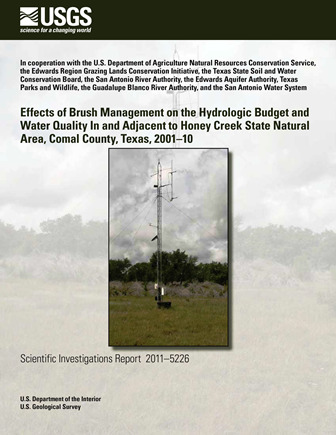Effects of Brush Management on the Hydrologic Budget and Water Quality In and Adjacent to Honey Creek State Natural Area, Comal County, Texas, 2001-10

| Author | Banta JR and Slattery RN (US Geological Survey) |
| Year | 2011 |
| Description | Effects of brush management on hydrologic budget and water quality. May not be generalizable to all locations. See Fact Sheet companion document of the same name. |
| Report Number | USGS SIR 2011-5226 |
| Publisher | US Geological Survey |
| Location | Comal County, Honey Creek State Natural Area |
| Cover | View Download |
| File | View Download |
| Summary |
|
Note: May not be generalizable to all locations. See Fact Sheet companion document of the same name. The U.S. Geological Survey, in cooperation with the U.S. Department of Agriculture Natural Resources Conservation Service, the Edwards Region Grazing Lands Conservation Initiative, the Texas State Soil and Water Conservation Board, the San Antonio River Authority, the Edwards Aquifer Authority, Texas Parks and Wildlife, the Guadalupe Blanco River Authority, and the San Antonio Water System, evaluated the hydrologic effects of ashe juniper (Juniperus ashei) removal as a brush management conservation practice in and adjacent to the Honey Creek State Natural Area in Comal County, Tex. By removing the ashe juniper and allowing native grasses to reestablish in the area as a brush management conservation practice, the hydrology in the watershed might change. Using a simplified mass balance approach of the hydrologic cycle, the incoming rainfall was distributed to surface water runoff, evapotranspiration, or groundwater recharge. After hydrologic data were collected in adjacent watersheds for 3 years, brush management occurred on the treatment watershed while the reference watershed was left in its original condition. Hydrologic data were collected for another 6 years. Hydrologic data include rainfall, streamflow, evapotranspiration, and water quality. Groundwater recharge was not directly measured but potential groundwater recharge was calculated using a simplified mass balance approach. The resulting hydrologic datasets were examined for differences between the watersheds and between pre- and post-treatment periods to assess the effects of brush management. The streamflow to rainfall relation (expressed as event unit runoff to event rainfall relation) did not change between the watersheds during pre- and posttreatment periods. The daily evapotranspiration rates at the reference watershed and treatment watershed sites exhibited a seasonal cycle during the pre- and post-treatment periods, with intra- and interannual variability. Statistical analyses indicate the mean difference in daily evapotranspiration rates between the two watershed sites is greater during the post-treatment than the pre-treatment period. Average annual rainfall, streamflow, evapotranspiration, and potential groundwater-recharge conditions were incorporated into a single hydrologic budget (expressed as a percentage of the average annual rainfall) applied to each watershed before and after treatment to evaluate the effects of brush management. During the posttreatment period, the percent average annual unit runoff in the reference watershed was similar to that in the treatment watershed, however, the difference in percentages of average annual evapotranspiration and potential groundwater recharge were more appreciable between the reference and treatment watersheds than during the pre-treatment period. Using graphical comparisons, no notable differences in major ion or nutrient concentrations were found between samples collected at the reference watershed (site 1C) and treatment watershed (site 2C) during pre- and post-treatment periods. Suspended sediment loads were calculated from samples collected at sites 1C and 2T. The relation between suspended sediment loads and streamflow calculated from samples collected from sites 1C and 2T did not exhibit a statistically significant difference during the pre-treatment period, whereas during the post-treatment period, relation between suspended-sediment loads and streamflow did exhibit a statistically significant difference. The suspended sediment load to streamflow relations indicate that for the same streamflow, the suspended sediment loads calculated from site 2T were generally less than suspended-sediment loads calculated from site 1C during the post-treatment period. |
Search for Documents
Advance Search
Explore EAA's Scientific Reports
- All Reports
- Geomorphology and Caves
- Weather Modification
- Geology
- Water Use and Conservation
- Geochemistry
- Water Resources Planning and Management
- Floods and Drought
- Water Quality
- Climatology
- Surface Water / Groundwater Relationship
- Biology
- Springs, Groundwater Discharge
- Archaeology
- RZ Protection
- Aquifer Levels
- Remote Sensing
- Precipitation
- Overview Studies
- Modeling
- Hydrology and Hydrogeology
- History
- Groundwater Recharge, Recharge Zone
- Groundwater Movement
